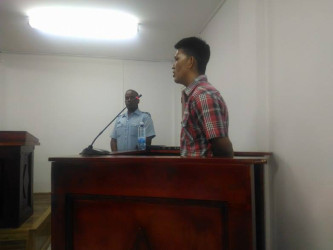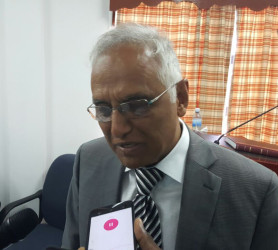An inmate yesterday testified that Deputy Prisons Director Gladwin Samuels had ordered that the door to the Capital A section be closed prior to the fire inside that claimed the lives of 17 prisoners at the Camp Street Prison.
Taking the witness stand before members of the Commission of Inquiry (CoI) into the prisoner deaths was Desmond James, who was one of the inmates who was caught in the blaze. He, however, managed to escape with only burns to his knee.
The evidence of James and inmates who have testified before him continue to cast doubts on efforts by prison officers to rescue the prisoners during the time they were trapped in the fire on the morning of March 3rd. However, attorney for the Guyana Prison Service and the Guyana Police Force, Selwyn Pieters yesterday told reporters that the prison had already submitted video evidence to the CoI to prove efforts were indeed made to save the men from the fire. He said that footage would be played at an appropriate time.
Recounting the day of the fire, James said he had been on his way out of the dorm when an order came from Samuels for the door to the Capital A Division to be closed.
(Samuels was sent on six weeks of leave in the wake of allegations made against him by inmates after the fire.)
Later, under cross-examination by Pieters, James admitted that although he did not see Samuels at the time he allegedly made the order, he was familiar with his voice as he usually frequents the Capital Division.
The prisoner recalled that after Samuels issued the command to, “Lock the door and leff dem inside,” he rested his bag near the door and went back to his bed space. He, like two others before him, stated that after the door was closed, prisoners began making a hole in the wall separating Division A, where he resided, and Division B and jumping over into the other dorm. (On Wednesday, prisoner Michael Lewis testified that the wall was broken the night before.)

James said that the prisoners returned back to Capital A through the hole after prison officers threatened to shoot them. Another inmate, Errol Kesney, had previously testified that Samuels passed an order for the officers to “hurry and lock back the door.” Kesney related that he then had jumped back through the hole, returning to Capital A, at which point he saw a small fire had started in the room.
James related that the fire had not started until after officers had removed all the prisoners from the Capital B Division. He, like the others, could not say who lit the fire.
Also similar to the testimony of the other witnesses, he recalled seeing an extinguisher used to ease the flames but said he was not sure if the fire was put out at that point since soon after he saw “a heavy smoke” come into the room. The inmate said the smoke “started at one corner, went up to the ceiling and came back around.”
He, like the other inmates before him, said he had retreated to a door to the north of the dorm where he could receive fresh air. He named Errol Kesney, Samuel Alleyne, Michael Lewis, Anthony Joseph and “Farmer” as some of the 13 inmates he could recall being beside him at the time.
He also stated that from where he was lying on the floor, he could see inmate Rayon Paddy, who had gone into the smoke to save a friend—an inmate called “Elephant.” He recalled that when Paddy had returned, his skin had been badly burnt.
James said he was rescued by a fellow inmate from the old Capital Division.
Valiant effort

During cross-examination, Pieters put it to James that on the day of the fire, he had not gone to the back of the room like he claimed. He alleged that he had in fact stayed at the front and had witnessed when officials “extracted the ringleaders” from the group after they were escorted onto the tarmac. He also suggested that James was among the group of inmates who placed a cork to block the keyhole so the door of Capital A could not be opened from the outside. These claims were all denied.
Pieters suggested further that the witness was actually one of the inmates at the back of the room and further that were he lying as close to Paddy as he said, he would have sustained more severe burns. (James had stated that he was not taken to the hospital after he came out of the building, but was escorted by an officer to sit in a tailor’s shop). He claimed that the reason James had little injury was because he was near the door, where officials had been pouring water to out the fire. James refuted these claims.
Under examination by attorney Dexter Todd, who is appearing on behalf of one of the injured inmates, James said he was unaware of any plans by any of the inmates related to killing anyone in the Capital A Division, lighting themselves afire or to burn down the Division. He also denied that Delroy Williams, a client of Todd’s who passed in the fire that he was acquainted with, had told him of intentions to light himself and the Division afire. Todd asked similar questions in relation to his other client, Marcellous Verbeke, who suffered severe burns on the day in question and these too were denied by James.
Pieters, meanwhile, told reporters during an adjournment that the recording that was handed over showed that prison authorities had done everything within their mandate to rescue prisoners and had even gone beyond their call of duty, risking their lives.
“You will be able to see the valiant effort of the prison officers. And I have to tell you this—not only the inmates of the Georgetown Prison have suffered; the entire Georgetown prison is in mourning—-from the Superintendent right down to the lowest ranking warden… we’re not trying to blame the victims, we’re very sorry for what took place, but those inmates, had they followed the directions of the officers, no lives would have been lost,” he said.
Pieters said that on the day of the fire, the inmates had refused to exit the dorm, barricaded the door, and forced prison officers to go risk life and limb to save them.
Fundamental rights
Meanwhile, yesterday’s proceedings, set to begin at 10am, started a few minutes late but was then delayed for close to an hour while Pieters and attorney Christopher Ram contested the appropriateness of an oral submission Ram made in relation to an inmate’s statement.
Much of the conflict arose from confusion about the rules of evidence that govern the tribunal and which has been questioned several times since the CoI commenced.
Chairman of the CoI Justice James Patterson repeatedly said that the strict rules of evidence will not prevail and can be relaxed where justice applies.
In response to the position taken by the Chairman and led by a particular line of questioning directed to James by Peters, Todd raised an objection and called for fairness, even where strict rules will not be adhered to.
“I know that the Chairman did say that the Commission is not going to stick to the strict rules of evidence. But even in saying that, there has to be some level of control and reasonableness in the questions that are asked,” Todd advanced.
The accepted procedure came into question at the start of the proceedings, when Ram, the Guyana Bar Association (GBA) President, called for representation for all witnesses testifying before the CoI.
Ram made this submission after he was informed by James that he was not made aware of his right to have an attorney present when giving his statement or his fundamental right to counsel. When asked, the prisoner said that he would like to be represented. Ram stated that the inmates are not “denuded of their fundamental rights because they are prisoners.”
He further submitted that those that died as a result of the tragedy did so while in the custody of the state and, as a result, the state should be invited to provide counsel for every witness.
Pieters, while he agreed that witnesses have the right to counsel and in this case, even the possibility of state-funded representation, said he would have been willing to support the request had Ram made a “proper application.” “Proper” being one in which his requests were written and served to the interested parties.
Ram countered by saying he was not aware that an oral submission was improper and finally stated, “This is why I keep saying we need to have proper rules. These are not rules, they are guidelines,” he stated, referencing a document in hand.
The rules again came into question when Ram raised concerns about questioning related to the James’ statement, while stating that it had not been properly tendered.
James, like the witnesses before him, told the Commission that his statement was written by a man purported to be another inmate. James was, however, unable to verify the section of the prison in which the inmate resides as he stated he had never seen him before.
According to him, he, along with another prisoner, met with the man in the library without the presence of any welfare or prison officials. He said that because it was lockdown time, there was a rush and there was no opportunity for the statement to be read back to him. He did, however, state, that the prisoner told him that he would “complete the statement” in the morning and promised to read it to him later. This was never done. On Wednesday, inmate Michael Lewis had also testified that his statement, which was incomplete at the time it was submitted, had not been read to him upon completion.
The CoI was set up by President David Granger to enquire into all the circumstances surrounding the death of the 17 prisoners and to make recommendations on any action that should be taken to avoid a recurrence. It will also investigate, examine and report on the causes, circumstances and conditions that led to the fatal disturbances and also determine whether the conduct of the staff of the Guyana Prison Service in any way contributed to the prisoner deaths.




